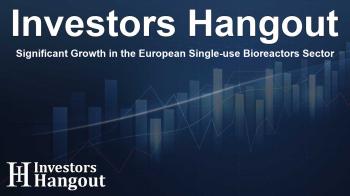Significant Growth in the European Single-use Bioreactors Sector

Europe's Bioreactor Landscape: Growth and Innovation
The European single-use bioreactors market is on the rise, projected to achieve a considerable value of $3.34 billion by the early 2030s. This impressive growth forecast is influenced by several factors, including advancements in technology, an expanding biopharmaceutical sector, and governmental support aimed at enhancing bioproduction capabilities.
Driving Forces Behind Market Expansion
The surge in the single-use bioreactors market can be largely attributed to the swift adoption of disposable technology across the pharmaceutical and biotechnology industries. As biopharmaceutical demands grow and traditional drug development becomes more expensive, companies are turning to innovative solutions for biologicals and biosimilars. This shift is further propelled by favorable government initiatives aimed at fostering bioproduction and enhancing the infrastructure necessary for biopharma products.
The Role of Advanced Technologies
Significant investments in advanced bioprocessing technologies are key to transforming the industry. Companies are focusing on sustainable manufacturing practices while enhancing their product offerings for various applications, particularly in mammalian cell cultures. This commitment to innovation ensures that organizations can meet the rising demand for contamination-free and flexible bioprocessing solutions.
Market Insights by Product and Application
In terms of product segments, the Media Bags segment is set to experience the highest growth rate, driven by their flexibility, lower extraction levels, and stability compared to traditional vessels. Single-use bioreactor systems are anticipated to maintain the largest market share due to their viability as comprehensive bioprocessing solutions that alleviate the need for costly cleaning processes.
Focus on Key Segments
Among the various bioreactor types, wave-induced bioreactors are projected to grow rapidly, thanks to their unique ability to enhance cell culture conditions by optimizing fluid dynamics. For cell types, mammalian cells are expected to dominate as demand rises for consistent monoclonal antibody production, indicating a preference for scalable bioprocessing techniques.
Research bio-production applications are also poised for notable growth, buoyed by regulatory support and investment in research initiatives. Major companies in this segment are demonstrating effective strategies that reflect the overall positive trajectory for research-driven applications in the market.
Regional Strengths and Market Dynamics
Leading the market, Germany holds a significant share due to its robust pharmaceutical export activities and government support for biotechnology. In contrast, France is emerging as a high-growth segment, thanks to initiatives encouraging biosimilar adoption and steady increases in healthcare investments. The strategic positioning of these countries within the European Union bolsters their market strength and fosters innovation.
Emerging Opportunities
There are ample opportunities for growth stemming from increased government support for bioproduction, partnerships among Contract Development and Manufacturing Organizations (CDMOs), and advancements in personalized medicine. Companies are tapping into new revenues via specialized therapies and bioprocessing ecosystems, expanding their manufacturing capabilities to meet the demands of next-generation biologics.
Key Players and Competitive Intelligence
A diverse and competitive landscape characterizes the European single-use bioreactors market, with leading bioprocessing technology firms vying for market share. Companies are actively investing in integrated bioprocessing platforms that prioritize advanced single-use technologies along with automated control systems.
Trends Catalyzing Market Innovation
The industry is witnessing substantial shifts, with strategic acquisitions and partnerships enhancing the capabilities of market players. Regulatory bodies are enhancing the standards in the sector, prompting companies to improve their compliance protocols. Recent innovations in single-use technologies are enabling increased efficiency and performance within cell culture practices.
Frequently Asked Questions
What is the projected market size for single-use bioreactors in Europe?
The European single-use bioreactors market is expected to reach $3.34 billion by 2032.
What factors are driving the growth of this market?
Rapid technology adoption, government support for bioproduction, and an expanding biopharmaceutical sector are the key drivers.
Which product segment will lead the market growth?
The Media Bags segment is projected to register the highest CAGR due to its flexibility and efficiency.
What role does Germany play in the European single-use bioreactor market?
Germany holds the largest market share, driven by pharmaceutical exports and supportive government initiatives.
How are companies responding to market demands?
Companies are investing in advanced technologies and forming partnerships to enhance their bioproduction capabilities and meet regulatory standards.
About The Author
Contact Logan Wright privately here. Or send an email with ATTN: Logan Wright as the subject to contact@investorshangout.com.
About Investors Hangout
Investors Hangout is a leading online stock forum for financial discussion and learning, offering a wide range of free tools and resources. It draws in traders of all levels, who exchange market knowledge, investigate trading tactics, and keep an eye on industry developments in real time. Featuring financial articles, stock message boards, quotes, charts, company profiles, and live news updates. Through cooperative learning and a wealth of informational resources, it helps users from novices creating their first portfolios to experts honing their techniques. Join Investors Hangout today: https://investorshangout.com/
The content of this article is based on factual, publicly available information and does not represent legal, financial, or investment advice. Investors Hangout does not offer financial advice, and the author is not a licensed financial advisor. Consult a qualified advisor before making any financial or investment decisions based on this article. This article should not be considered advice to purchase, sell, or hold any securities or other investments. If any of the material provided here is inaccurate, please contact us for corrections.

